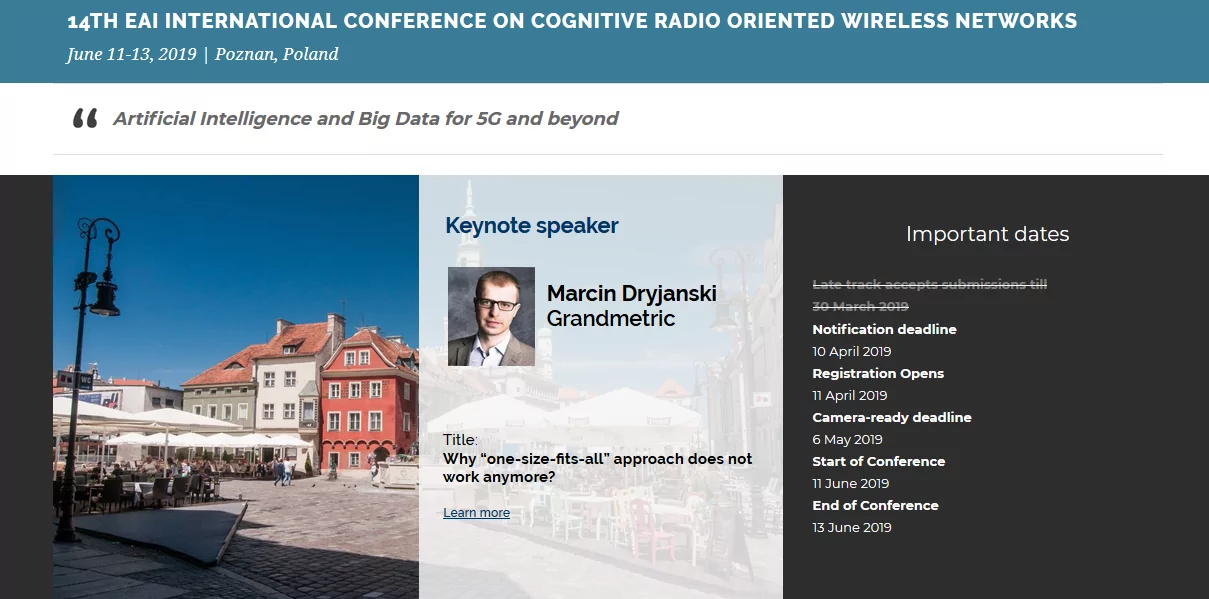
Keynote
Our team member and Grandmetric co-founder Marcin Dryjanski will give a keynote speech entitled: “Why “one-size-fits-all” approach does not work anymore?” during EAI Crowncom Conference on the 11th of June 2019 in Poznan.
More details about the talk, below.
Why “one-size-fits-all” approach does not work anymore?
Abstract: The history of wireless systems shows that the technology has developed to serve a particular purpose (e.g. 2G for Voice, 4G for IP connectivity). On the other hand, the services are evolving as well, and this requires additional features to the existing systems to realize the dedicated aspect. As with the advent of 5G it has become obvious that the services that the network will have to cope with have different requirements, there are at least three possible ways to handle these requirements. First – we could get to a point where due to the fragmentation of the supporting technologies we would need to design separated systems to realize the requirements. Second, evolving the existing systems with “add-on” features to realize a particular function. Third, and the one discussed in this talk, is to provide a natively unified and hierarchical approach to the design of the system. To handle to the heterogeneity of: radio-access technologies (RATs), spectrum, devices, service mixes, features, we can create a framework being a hybrid mechanism, with the three main components: a unified upper-layer (independently handling the context from the underlying technology), an abstraction middle-layer (enabling an “easy” add-on of the below techniques), and a specialized lower-layer (to best serve a particular purpose). In this context, the “one-size fits all” is no longer true, as we should rather coordinate multiple features and technologies which are optimized for the specific requirements.
The talk will take place on 11.06.2019 at 9:15.
Panel session
Marcin will also take part in the panel session, along with Seppo Yrjölä from Nokia, Stefan Parkvall from Ericsson, Heikki Kokkinen from Fairspectrum and Karol Kowalik from Inea.
Timely access to spectrum will unlock novel 5G businesses
Abstract: Key to the success of 5G services is the ability to timely access suitable harmonized mobile spectrum in required locations on appropriate terms based on the needs of the use case and the business model. In terms of global harmonization, 3GPP and ITU are moving forward with standards and spectrum for 5G with special focus on emerging novel use cases (IoT, digital automation, smart cities, augmented/virtual reality) with diverse requirements. No wireless 5G services can be provided credibly and scalable without internationally agreed technical specifications and access to sufficient amount of harmonized radio spectrum. Spectrum is an essential enabler for 5G, and significant changes in spectrum characteristics are expected with respect to previous generations, including the amount and bandwidth of spectrum, type of spectral bands, and also, the ways of authorizing the use of spectrum, including unlicensed and shared use. In particular, different spectrum sharing mechanisms would inevitably lead to a range of novel implementation solutions and business models, ranging from stand alone to hosting on a public mobile network or a dedicated wholesale network. Flexible 5G NR framework will natively support different spectrum types: licensed, shared and unlicensed, and new sharing paradigms through scalable OFDM-based interface, TDD self-contained and flexible slot-based structure, network MIMO and mobile mmWaves. For example, utilization of higher spectrum bands at mmWaves calls for small cells and local spectrum licensing as the radio range will be very small compared to current spectrum bands. Unbundling investments in spectrum, infrastructure and services will lower entry barrier for new service providers and leads to new incentives for local players for building and operating networks, as well as offering localized context depended services. This panel would give an overview of the current status in spectrum for 5G, and what kinds of novel deployment solutions and business models could be expected via different spectrum types and sharing schemes.
The panel will take place on 12.06.2019 at 12:45.
The conference
The main goal of CROWNCOM 2019 is to bring together researchers and present their new solutions of cognitive radio systems and their potential help with delivering required stringent requirements of future 5G and beyond 5G networks.
The event is organized by European Alliance for Innovation and Poznań University of Technology with Honorary Patronage of the Mayor of Poznań.
The main conference web.
 Company
Company